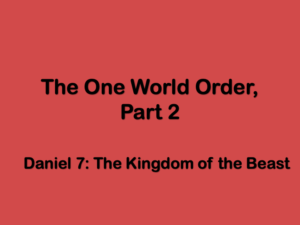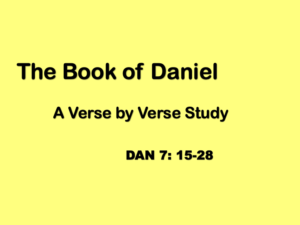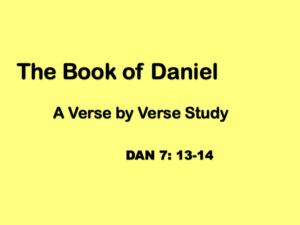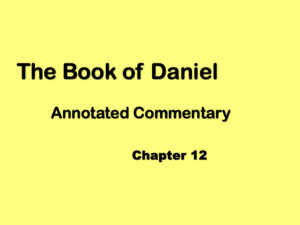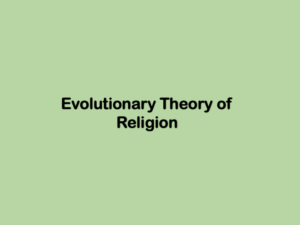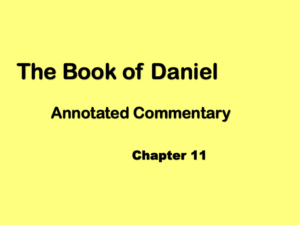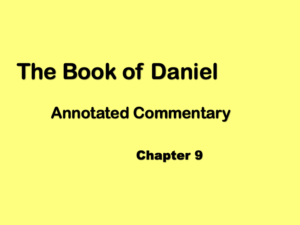Daniel 7: 9-12 The Throne Room of God
After describing four beast that will arise from the ocean, Daniel’s vision moves to heaven, where he sees the throne room of God and a court of judgement is set up.
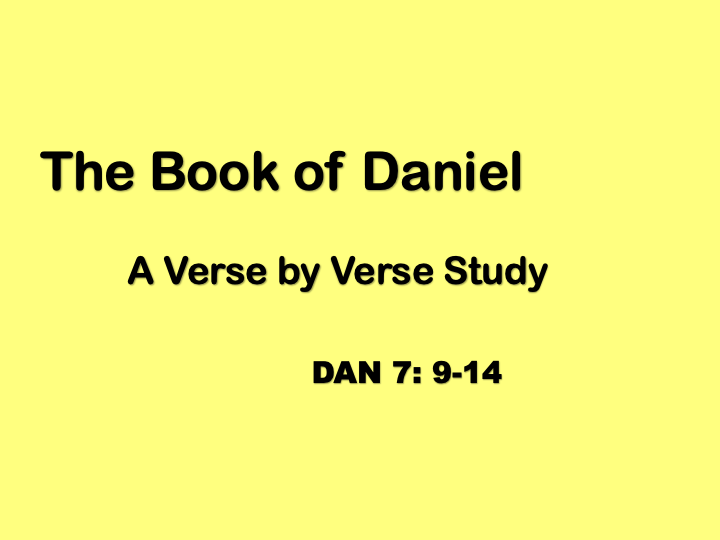
After describing the four beasts that emerge from the sea, Daniel’s vision transitions to a throne room in heaven. Up until this point, Daniel’s vision has roughly followed the outline of Nebuchadnezzar’s dream in chapter 2, but the throne room is a new detail not previously described in Nebuchadnezzar’s dream.
“I watched until thrones were placed,
and one who was ancient of days sat.
His clothing was white as snow,
And the hair of his head like pure wool.
His throne was fiery flames,
and its wheels burning fire.
A fiery stream issued and came out from him:
Thousands and thousands ministered to him,
And ten thousand times ten thousand stood before him.
The judgment was set,
And the books were opened.
Daniel 7: 9-10
At the beginning of this portion of the vision, thrones are set up, but other than the Ancient of Days, we are not told who sits in the thrones. Some commentators view the multiple thrones as a reference to the trinity of God, but others view it as the assembling of God’s divine council, when assembles his court of supernatural advisors for a decision or a judgement. We learn in verse 10 that this court is indeed assembled for a judgement, specifically a judgement of the fourth beast and the little horn. Very similar imagery is later used in Revelation chapter 4, when John is taken up to the throne room of God
The Ancient of Days
The title Ancient of Days is not found anywhere else in the Bible except Daniel chapter 7, which makes it a little more difficult to interpret. Most commentators consider it to be a reference to God, based on the scene of the heavenly throne room, the imagery used to describe the Ancient of Days, and the fact that the Ancient of Days sits in judgment. Other interpretations of the identity of the Ancient of Days include Jesus, an unspecificed angel, or the angel Michael.
In the Bible, white clothing reflects holiness, and the Ancient of Days is dressed in white, so he is portrayed as Holy. Hair like wool is associated with age and wisdom, so here it is used to reflect the wisdom and eternality of the Ancient of Days.
The throne of the Ancient of Days and its wheels are on fire. There are three other detailed descriptions of the throne room of God in the Bible: two in the Old Testament, Isaiah chapter 6 and Ezekiel chapter 1, and one in the New Testament: Revelation chapter 4. All four visions share common elements, and in Ezekiel, God’ throne is also associated with fire:
“Above the expanse that was over their heads was the likeness of a throne, as the appearance of a sapphire stone; and on the likeness of the throne was a likeness as the appearance of a man on it above. I saw as it were glowing metal, as the appearance of fire within it all around, from the appearance of his waist and upward; and from the appearance of his waist and downward I saw as it were the appearance of fire, and there was brightness around him.
Ezekiel 1: 26-27
Fire is also often associated with God’s presence outside of His throne room. In Exodus chapter 3, God appears to Moses as a burning bush.
Now Moses was keeping the flock of Jethro, his father-in-law, the priest of Midian, and he led the flock to the back of the wilderness, and came to God’s mountain, to Horeb. Yahweh’s angle appeared to him in a flame of fire out of the middle of a bush. He looked, and behold, the bush burned with fire, and the bush was not consumed, Moses said, “I will turn aside now, and see this great sight, why the bush is not burned.”
When Yahweh saw that he turned aside to see, God called to him out of the middle of the bush, and said, “Moses! Moses!”
Exodus 3: 1-4
Later in Exodus, God again appears to Moses and the people of Israel as fire.
On the third day, when it was morning, there were thunders and lightnings, and a thick cloud on the mountain, and the sound of an exceedingly loud trumpet; and all the people who were in the camp trembled. Moses led the people out of the camp to meet God; and they stood at the lower part of the mountain. All of Mount Sinai smoked, because Yahweh descended on it in fire; and its smoke ascended like the smoke of a furnace, and the whole mountain quaked greatly.
Exodus 19: 16-18
The refence to the wheels of fire seems as little strange at first, but in Ezekiel chapter 1, God’s throne is portrayed as a chariot pulled by four cherubim.
When the living creatures went, the wheels went beside them; and when the living creatures were lifted up from the earth, the wheels were lifted up. Wherever the spirit was to go, they went; there was the spirit to go: and the wheels were lifted up beside them; for the spirits of the living creature was in the wheels.
Ezekiel 1: 19-20
The mention of wheels, then seems to be a reference to the fact that God’s throne is a chariot, although that fact is not elaborated in Daniel, but rather in the writing of Ezekiel, a contemporary of Daniel.
A Court of Judgement
The fire issuing out from God may be further reference to the divine presence, or it may be a sign of judgment, as some commentators suggest. In Revelation chapter 19, the Antichrist and the false prophet are thrown in a lake of fire, so the fire coming forth from the throne may be a reference to this future punishment.
The beast was taken, and with him the false prophet who worked the signs in his sight, with which he deceived those who had received the mark of the beast and those who worshiped his image. These two were thrown alive into the lake of fire that burns with sulfur.
Revelation 19: 20
Building on this imagery, Daniel’s vision later tells us the fourth beast will be burned with fire. The text then describes the other attendants in God’s court, but does not tell us who they are, other that “thousands of thousands ministered to him, and ten thousand times ten thousand stood before him.” Most commentators agree the ministers and attendants are members of God’s divine council, supernatural beings, such as angels, who help God rule. In later chapters, Daniel revisits the topic of angels and also introduces the topic of spiritual warfare.
In Nebuchadnezzar’s dream, the statue, representing the kingdoms of men, was destroyed by a stone, representing the Kingdom of God. Building on the earlier imagery, Daniel now describes a scene of judgement, “The judgment was set, and the books were opened.”
Here the text confirms God has indeed assembled his council for a judgment; Daniel’s vision is the scene of a divine trial. The books that are opened seem to be a reference to books in which deeds are written. This is a common theme in the Old and New Testament and here the books seem to be used as evidence against the fourth kingdom, for judgement is then carried out.
“I watched at that time because of the voice of the great words which the horn spoke. I watched even until the animal was slain, and its body destroyed, and it was given to be burned with fire. As for the rest of the animals, their dominion was taken away, yet their lives were prolonged for a season and a time.
Daniel 7: 11-12
God calls his court to judge the fourth beast, the final kingdom of man. This kingdom is destroyed and burned up. Judgement is also passed on the little horn, the one who spoke “great words.” Interestingly, the first three kingdoms, Babylon, Persia and Greece, are not destroyed, but their rule is taken away. This implies that while the final kingdom, the Kingdom of the Beast, ruled by the antichrist, will be destroyed, the previous three kingdoms will continue to exist, at least in some form. Another interpretation is that Babylon, Persia and Greece all did indeed continue to exist after the fall of their respective empires, but never again did they achieve the level of dominance they had previously held.
When taken together with Nebuchadnezzar’s dream in chapter 2, we can construct a reasonable sequence of events: four kingdoms will arise. The fourth kingdom will be unlike any kingdom that ever arose before, it will have 10 rulers, but will be taken over by the Antichrist. Finally, God will judge this final, fourth kingdom, before replacing it with His kingdom, the Kingdom of God.
In the next post, we will discuss the “son of man,” who is given dominion, or rulership by the Ancient of Days.
Previous: Daniel 7: 7-8 The Fourth Beast and the Antichrist
Next: Daniel 13-14 The Son of Man
